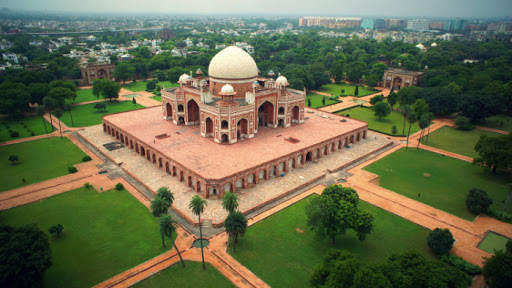
While the main tomb took over eight years to build, it was also placed in centre of a 30-acre (120,000 m2) Char Bagh (Four Gardens), a Persian-style garden with quadrilateral layout and was the first of its kind in the South Asia region in such a scale.The highly geometrical and enclosed Paradise garden is divided into four squares by paved walkways (khiyabans) and two bisecting central water channels, reflecting the four rivers that flow in jannat, the Islamic concept of paradise. Each of the four square is further divided into smaller squares with pathways, creating into 36 squares in all, a design typical of later Mughal gardens. The central water channels appear to be disappearing beneath the tomb structure and reappearing on the other side in a straight line, suggesting the Quranic verse, which talks of rivers flowing beneath the 'Garden of Paradise'. Standing in the center at the place where the main axes intersect, the tomb resembles the form and position of a garden pavilion. But here it marks the place where the body of the deceased ruler rests. “The garden is about sovereignty, and the mausoleum is about dynasty. When the mausoleum is implanted in a garden, as it is at Humayun’s tomb, sovereignty and dynasty are combined in a teleological statement that the king is king as he always has been and always will be.” The entire tomb and the garden is enclosed within high rubble walls on three sides, the fourth side was meant to be the river Yamuna, which has since shifted course away from the structure. The central walkways, terminate at two gates: a main one in the southern wall, and a smaller one in the western wall. It has two double-storey entrances, the West gate which used now, while the South gate, which was used during Mughal era, now remains closed. Aligned at the centre on the eastern wall lies a baradari, literally a pavilion with twelve doors, which is a building or room with twelve doors designed to allow the free draught of air through it, finally on the northern wall lies a hammam, a bath chamber.